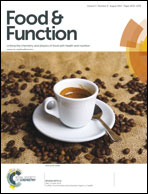Hepatoprotective effects of secoiridoid-rich extracts from Gentiana cruciata L. against carbon tetrachloride induced liver damage in rats
Abstract
The objective of this work was to investigate the effects of the methanol extracts of Gentiana cruciata L. aerial parts (GCA) and roots (GCR) against carbon tetrachloride-induced liver injury in rats. Pretreatment with GCA and GCR, containing sweroside, swertiamarin and gentiopicrin in high concentrations, dose-dependently and significantly decreased the levels of serum transaminases, alkaline phosphatase and total bilirubin, whereas an increase in the level of total protein was found compared with the CCl4-treated group. Moreover, oral administration of extracts significantly enhanced antioxidant enzyme activities (superoxide dismutase and catalase), increased the content of glutathione and decreased the content of TBARS. Microscopic evaluations of the liver revealed CCl4-induced lesions and related toxic manifestations that were minimal in the liver of rats pretreated with extracts at the dose of 400 mg per kg b.w. The results suggest that the use of G. cruciata extracts has a merit as a potent candidate in protecting the liver against chemical induced toxicity.


 Please wait while we load your content...
Please wait while we load your content...